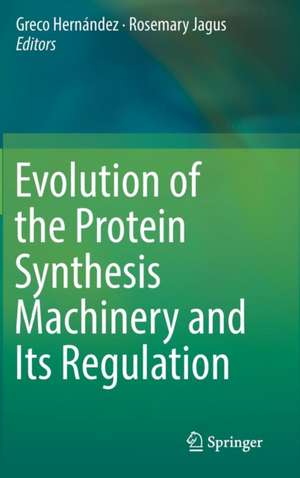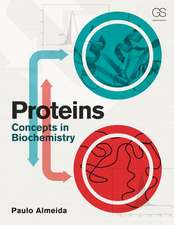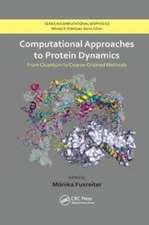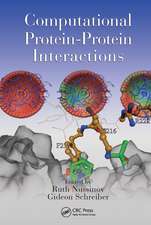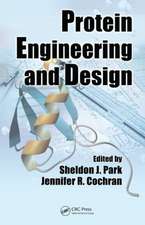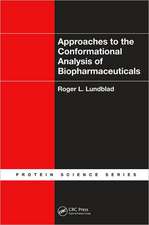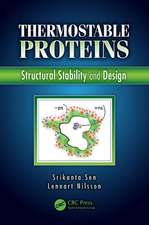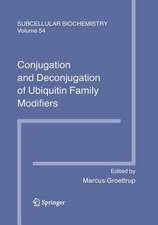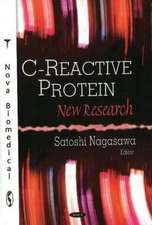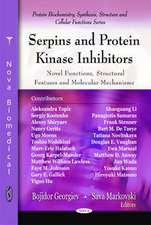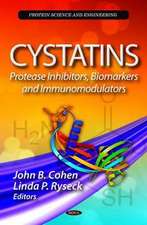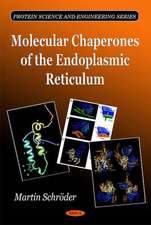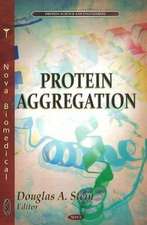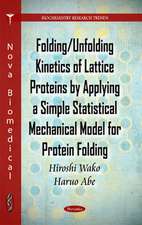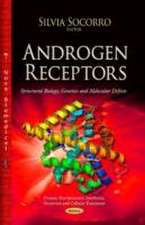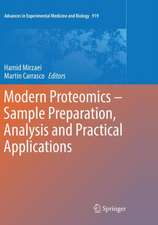Evolution of the Protein Synthesis Machinery and Its Regulation
Editat de Greco Hernández, Rosemary Jagusen Limba Engleză Hardback – 18 aug 2016
| Toate formatele și edițiile | Preț | Express |
|---|---|---|
| Paperback (1) | 1829.05 lei 6-8 săpt. | |
| Springer International Publishing – 21 apr 2018 | 1829.05 lei 6-8 săpt. | |
| Hardback (1) | 1835.39 lei 6-8 săpt. | |
| Springer International Publishing – 18 aug 2016 | 1835.39 lei 6-8 săpt. |
Preț: 1835.39 lei
Preț vechi: 2238.29 lei
-18% Nou
Puncte Express: 2753
Preț estimativ în valută:
351.26€ • 365.75$ • 296.85£
351.26€ • 365.75$ • 296.85£
Carte tipărită la comandă
Livrare economică 10-24 martie
Preluare comenzi: 021 569.72.76
Specificații
ISBN-13: 9783319394671
ISBN-10: 3319394673
Pagini: 460
Ilustrații: IX, 564 p. 92 illus., 69 illus. in color.
Dimensiuni: 155 x 235 x 32 mm
Greutate: 0.98 kg
Ediția:1st ed. 2016
Editura: Springer International Publishing
Colecția Springer
Locul publicării:Cham, Switzerland
ISBN-10: 3319394673
Pagini: 460
Ilustrații: IX, 564 p. 92 illus., 69 illus. in color.
Dimensiuni: 155 x 235 x 32 mm
Greutate: 0.98 kg
Ediția:1st ed. 2016
Editura: Springer International Publishing
Colecția Springer
Locul publicării:Cham, Switzerland
Cuprins
Table of Contents
A review on the origin of the different codes for translation: Marco V. José, National University of México, México.
Evolution of ribosomes: Williams and Anton Petrov.
Origins and early evolution of ribosomes: George Fox, University of Houston.
Evolution of ribosomes and ribosomal proteins: Gustavo Caetano-Anolles.
Evolution of Class II aminoacyl synthetases from the antisense of the genes for Class I: Charles W. Carter, UNC.The translation process during the evolutionary transition from prokaryotes to eukaryotes: Greco Hernández, Vincent G. Osnaya, Alejandra García and Miguel L. García-León, National Institute of Cancer, México.
Evolution of translational control: from archaea to eukarya: Dario Benelli, Anna La Teana and Paola Londei, Sapienza University of Rome, Italy.
Distribution of elongation family GTPases EF1A and EFL in basal alveolate lineages: P. J. Keeling.
Evolution of mRNA structure; the eukaryotic mRNA 5´- and 3´- untranslated regions and their role in translational regulation:
Graziano Pesole.How lower eukaryotes contribute on our understanding of eIF4E-dependent translation: Daniela Ross and Michael Altmann, University of Bern, Switzerland.
Evolution of functionally divergent eIF4Es and their roles in the regulation of mRNA recruitment and developmental processes: Gritta Tettweiler, Nahum Sonenberg, Paul Lasko and Greco Hernández, McGill University, Montreal, Canada, and National Institute of Cancer, Mexico.
Evolution of eIF4E and eIF4G interactions in trypanosomes: O. P. de-Melo-Neto
Evolution of the functionally divergent eIF4E family members in deuterostomes: Rosemary Jagus, Kate Gillespie, Tsetso Bachvaroff, University of Maryland.
Evolution of the eIF2alpha kinases and translational control: Stephan Rosenberg
Evolution and use of eIF2alpha kinases in the apicomplexans and their role in life history of the parasites Plasmodium falciparum and Toxoplasma gondii: Ronald Wek and Sullivan.
Evolution of the TOR pathway and translational regulation: M. E. Cardenas.
Origin and diversification of eIF4E-binding proteins. Rosemary Jagus and Greco Her
nández. University of Maryland and National Institute of cáncer, Mexico.Evolution of the protein synthesis machinery in mitochondria: Yolanda Camacho-Villasana, Angélica Zamudio-Ochoa, Rodolfo García-Villegas Aldo E. García-Guerrero and Xochitl Pérez-Martínez, National University of Mexico, Mexico.
Relationship between plant translation initiatio
n factors and RNA viruses: An evolutionary perspective. Tzvetanka Dinkova and León Martínez, National University of Mexico, Mexico.Evolution of miRNAs and RNA binding proteins in eukaryotes: Luiz O. Penalva, Marcia Santos and Erzsebet Kokovay, University of Texas.
Evolution of silencing foci across eukaryotes: Rolando Rivera-Pomar, Carla Layana and Paola Ferrero, National University of La Plata, Argentina.Evolutionary conservation of the machineries coupling RNA transport with translation in eukaryotes: Paula Vazquez-Pianzola, Greco Hernández and Beat Suter, University of Bern, Switzerland, and National Institute of Cancer, Mexico.
A review on the origin of the different codes for translation: Marco V. José, National University of México, México.
Evolution of ribosomes: Williams and Anton Petrov.
Origins and early evolution of ribosomes: George Fox, University of Houston.
Evolution of ribosomes and ribosomal proteins: Gustavo Caetano-Anolles.
Evolution of Class II aminoacyl synthetases from the antisense of the genes for Class I: Charles W. Carter, UNC.The translation process during the evolutionary transition from prokaryotes to eukaryotes: Greco Hernández, Vincent G. Osnaya, Alejandra García and Miguel L. García-León, National Institute of Cancer, México.
Evolution of translational control: from archaea to eukarya: Dario Benelli, Anna La Teana and Paola Londei, Sapienza University of Rome, Italy.
Distribution of elongation family GTPases EF1A and EFL in basal alveolate lineages: P. J. Keeling.
Evolution of mRNA structure; the eukaryotic mRNA 5´- and 3´- untranslated regions and their role in translational regulation:
Graziano Pesole.How lower eukaryotes contribute on our understanding of eIF4E-dependent translation: Daniela Ross and Michael Altmann, University of Bern, Switzerland.
Evolution of functionally divergent eIF4Es and their roles in the regulation of mRNA recruitment and developmental processes: Gritta Tettweiler, Nahum Sonenberg, Paul Lasko and Greco Hernández, McGill University, Montreal, Canada, and National Institute of Cancer, Mexico.
Evolution of eIF4E and eIF4G interactions in trypanosomes: O. P. de-Melo-Neto
Evolution of the functionally divergent eIF4E family members in deuterostomes: Rosemary Jagus, Kate Gillespie, Tsetso Bachvaroff, University of Maryland.
Evolution of the eIF2alpha kinases and translational control: Stephan Rosenberg
Evolution and use of eIF2alpha kinases in the apicomplexans and their role in life history of the parasites Plasmodium falciparum and Toxoplasma gondii: Ronald Wek and Sullivan.
Evolution of the TOR pathway and translational regulation: M. E. Cardenas.
Origin and diversification of eIF4E-binding proteins. Rosemary Jagus and Greco Her
nández. University of Maryland and National Institute of cáncer, Mexico.Evolution of the protein synthesis machinery in mitochondria: Yolanda Camacho-Villasana, Angélica Zamudio-Ochoa, Rodolfo García-Villegas Aldo E. García-Guerrero and Xochitl Pérez-Martínez, National University of Mexico, Mexico.
Relationship between plant translation initiatio
n factors and RNA viruses: An evolutionary perspective. Tzvetanka Dinkova and León Martínez, National University of Mexico, Mexico.Evolution of miRNAs and RNA binding proteins in eukaryotes: Luiz O. Penalva, Marcia Santos and Erzsebet Kokovay, University of Texas.
Evolution of silencing foci across eukaryotes: Rolando Rivera-Pomar, Carla Layana and Paola Ferrero, National University of La Plata, Argentina.Evolutionary conservation of the machineries coupling RNA transport with translation in eukaryotes: Paula Vazquez-Pianzola, Greco Hernández and Beat Suter, University of Bern, Switzerland, and National Institute of Cancer, Mexico.
Notă biografică
Greco Hernández, PhD.
Division of Basic Research
National Institute for Cancer (INCan)
22 San Fernando Ave.
Tlalpan. 14080 Mexico City, Mexico
Phone: +52/55/56 28 04 33
Fax: +52/55/51 71 05 30
Email: greco.hernandez@gmail.com
Rosemary Jagus
Institute of Marine and Environmental Technology
University of Maryland Center for Environmental Science
701 E. Pratt StreetBaltimore MD 21202, U.S.
Email: jagus@umces.edu
Textul de pe ultima copertă
The “omics” era has given a new perspective to the findings on the origin and evolution of the process of translation. This book provides insight into the evolution of the translation process and machinery from a modern perspective. Written by leading experts in molecular biology, this text looks into the origins and evolution of the protein synthetic machinery.
Caracteristici
Provides a modern perspective on the translational machinery arising from wide availability of sequence data from genomes and transcriptomes of diverse organisms
Provides a more complete picture of the evolution of translational machinery
Provides a global perspective including diverse non-model organisms to understand the origin, evolution and diversification of the protein synthesis process
Includes supplementary material: sn.pub/extras
Provides a more complete picture of the evolution of translational machinery
Provides a global perspective including diverse non-model organisms to understand the origin, evolution and diversification of the protein synthesis process
Includes supplementary material: sn.pub/extras
